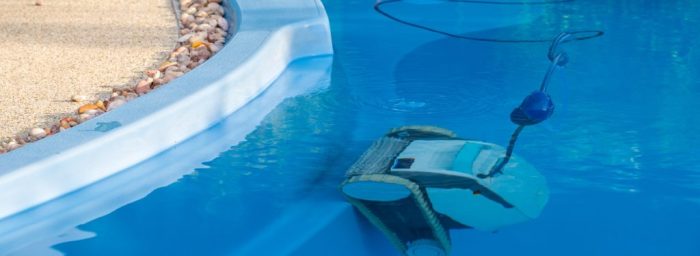
Smart pool automation systems are revolutionizing the way we maintain and enjoy our swimming pools. With advancements in technology, these systems not only simplify maintenance but also enhance energy efficiency and integrate seamlessly with home automation platforms.
Imagine a pool that knows when to clean itself, adjust its temperature, or even alert you about water quality—all while blending beautifully with your landscape. This overview delves into the features, technology trends, and practical insights that make smart pool automation an essential addition to modern homes.
Overview of Smart Pool Automation Systems

Smart pool automation systems revolutionize the way pool maintenance is conducted, integrating cutting-edge technologies to simplify tasks, enhance efficiency, and elevate the overall swimming experience. These systems empower pool owners with the ability to control various elements of their pools remotely, ensuring optimal conditions without the continuous manual effort traditionally required. Through automation, maintenance becomes more manageable, allowing for a greater focus on enjoyment and relaxation.The features of smart pool automation systems include real-time monitoring, automated cleaning, chemical balancing, and remote access through mobile applications.
These systems are designed to enhance energy efficiency by utilizing smart sensors and algorithms that optimize equipment operation, which in turn reduces power consumption and operating costs. Homeowners can save on energy bills while ensuring their pools are always at the perfect temperature and cleanliness standards through intuitive scheduling and alerts.
Latest Technology Trends in Smart Pool Automation
Recent advancements in technology have significantly influenced the landscape of smart pool automation. Key trends include the development of IoT-enabled devices that allow for seamless connectivity and data exchange. These devices can communicate with each other, providing users with comprehensive insights into pool conditions. For instance, a smart pump can adjust its operation based on the pool’s temperature or usage patterns, significantly enhancing energy efficiency.Moreover, the integration of AI (Artificial Intelligence) in these systems offers predictive maintenance capabilities.
By analyzing usage data and environmental factors, AI can foresee potential issues before they arise, reducing downtime and repair costs. As a result, pool owners can experience enhanced convenience and peace of mind.
Integration with Home Automation Platforms
Smart pool automation systems can easily integrate with existing home automation platforms, creating a cohesive smart home environment. This integration allows users to control pool functions alongside other smart devices, such as lighting, security systems, and HVAC through a single interface. For example, a homeowner can set their pool to heat up while coordinating smart lighting for an evening gathering, all managed from a smartphone app.The compatibility with popular home automation ecosystems like Google Home and Amazon Alexa further enhances user experience.
Voice commands can be used to control pool settings, providing a hands-free approach to pool management. This level of integration not only promotes energy savings but also enhances the comfort and convenience of pool ownership, making smart pool automation systems an essential investment for modern households.
The Role of Smart Pool Automation in Home Landscaping

Smart pool automation systems have revolutionized the way homeowners approach their outdoor spaces, integrating technology with aesthetics to create functional and visually appealing yards. The integration of smart technology in pool management not only streamlines maintenance but also enhances the overall look of the landscape, making it an essential part of modern home design.One of the key benefits of smart pool automation is its ability to seamlessly blend with various landscaping elements.
By utilizing automated systems, homeowners can maintain the pristine condition of their pools while ensuring that their surrounding environments, such as gardens, patios, and outdoor living areas, are equally well-kept. This convergence of technology and nature enhances not just usability, but also the overall aesthetic of the property.
Comparison of Traditional Pools versus Automated Pools
Understanding the differences between traditional and automated pools provides insight into the advantages of modern technology in maintaining your outdoor space. Traditional pools often require more manual labor and frequent maintenance, while automated pools leverage technology to optimize usability and upkeep.
- Maintenance: Traditional pools typically require regular skimming, chemical balancing, and manual cleaning, which can be time-consuming. In contrast, automated pools can monitor chemical levels, clean themselves, and even notify owners when maintenance is needed, significantly reducing the workload.
- Usability: Traditional pools often require manual adjustments of temperature and lighting. Automated systems allow for remote control of these features, meaning homeowners can adjust settings from their smartphones or tablets, providing convenience and enhancing the swimming experience.
- Energy Efficiency: Automated pools can optimize filtration and heating schedules based on usage patterns, which can lead to reduced energy costs. Traditional pools lack this level of efficiency and often run on a fixed schedule, regardless of actual usage.
Best Practices for Integrating Smart Systems with Landscaping Features
Integrating smart pool automation with existing landscaping features such as stone pathways, brick terraces, and garden beds requires thoughtful planning and execution. Effective integration not only maintains the integrity of these features but also enhances the overall functionality and appearance of the yard.To achieve seamless integration, consider the following best practices:
- Coordinated Design: Ensure that the layout of the smart pool area complements the surrounding landscaping. For example, using natural stone for pool decking can create a harmonious transition between the pool and garden.
- Concealment of Equipment: Strategically place pool automation equipment, such as pumps and sensors, in areas where they are not visually intrusive. This can be achieved by using decorative enclosures or natural screens, like hedges or trellises.
- Lighting Synchronization: Incorporate smart lighting that syncs with both the pool and landscape features. Programmable LED lights can enhance the ambiance during nighttime while highlighting the beauty of the surrounding garden.
Tools and Equipment for Smart Pool Automation
Setting up a smart pool automation system requires a combination of the right tools and equipment to ensure seamless operation and integration with existing backyard features. These technologies not only enhance the experience of pool ownership but also contribute to energy efficiency and maintenance ease. The following sections will explore essential tools, maintenance practices, and compatibility considerations for smart pool systems.
Essential Tools and Equipment for Smart Pool Automation
A variety of tools and equipment are necessary for properly installing and maintaining a smart pool automation system. Selecting the right components can significantly impact the effectiveness of your system and its ability to integrate with your home.
- Smart Control System: This is the brain of the operation, allowing for control of various pool features, such as lighting, heating, and filtration, from a single interface.
- Temperature Sensors: These devices monitor the pool water temperature and can adjust heating systems accordingly to maintain optimal conditions.
- Water Quality Sensors: Essential for monitoring pH and chlorine levels, ensuring the water remains safe and comfortable for swimmers.
- Automated Valves and Pumps: These components help manage water flow and filtration based on real-time data inputs from the control system.
- Smart Lighting Systems: Enhance the aesthetic appeal of the pool area while being programmable for various settings and times.
- Wi-Fi or Bluetooth Connectivity Devices: Ensure seamless communication between the smart pool system and user mobile devices or home automation hubs.
Maintenance and Troubleshooting for Smart Pool Technologies
Regular maintenance and troubleshooting are crucial for the longevity and efficiency of smart pool automation systems. Proper care ensures that all components function correctly and provides a safe swimming environment.
The following best practices can help maintain your system:
- Regularly Inspect Equipment: Monthly checks on sensors, pumps, and valves can prevent potential issues before they escalate.
- Software Updates: Ensure that your control system and any connected devices are updated regularly to incorporate new features and security fixes.
- Routine Cleaning: Keep sensors and equipment free of debris and buildup, as this can affect their performance.
- Monitor Alerts and Notifications: Many systems provide alerts for maintenance needs or operational issues; addressing these promptly can avoid costly repairs.
Compatibility with Existing Yard Equipment and Home Features
Smart pool automation systems are designed to integrate seamlessly with various existing yard equipment and home automation features. Compatibility is essential for creating a cohesive and efficient outdoor environment.
Factors to consider include:
- Communication Protocols: Ensure that the smart pool system uses compatible protocols (like Z-Wave or Zigbee) with other smart home devices.
- Power Supply Requirements: Assess whether existing electrical setups can support additional devices without requiring major upgrades.
- Integration with Landscaping Features: Consider how the pool automation can work in conjunction with outdoor lighting, irrigation systems, and other landscaping elements to create a unified ecosystem.
Wrap-Up
In summary, smart pool automation systems offer a myriad of benefits that go beyond mere convenience. They elevate the aesthetics of your outdoor space while providing functional advantages that save time and energy. Embracing this technology not only enhances your pool experience but also increases the overall value of your home.
Commonly Asked Questions
What are the key features of smart pool automation systems?
They typically include automated cleaning, temperature control, water quality monitoring, and integration with home automation platforms.
Can I install smart pool automation systems myself?
While some components are DIY-friendly, professional installation is recommended for complex systems to ensure compatibility and safety.
Do smart pool automation systems save on energy costs?
Yes, they can significantly reduce energy costs by optimizing pump and heater usage based on real-time data.
How do these systems integrate with existing home technologies?
Many smart pool automation systems are designed to work with popular home automation platforms, allowing for centralized control.
What maintenance is required for smart pool automation systems?
Regular checks on sensors, software updates, and occasional cleaning of equipment are usually sufficient to keep them running smoothly.





